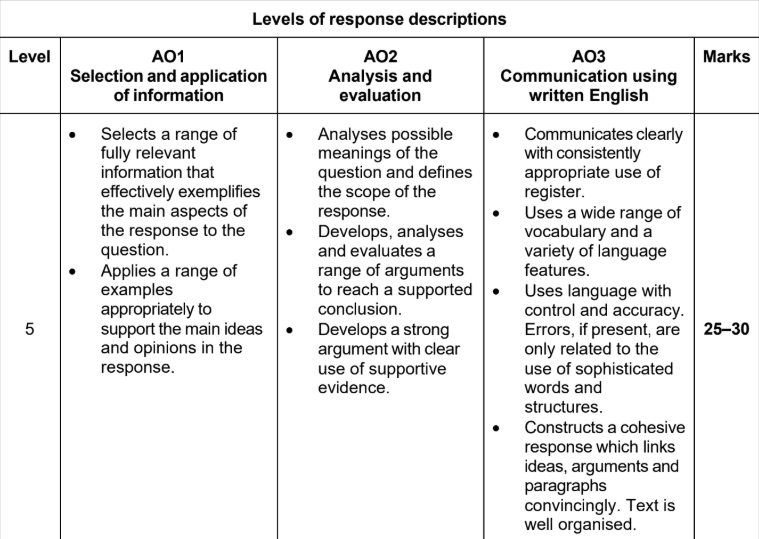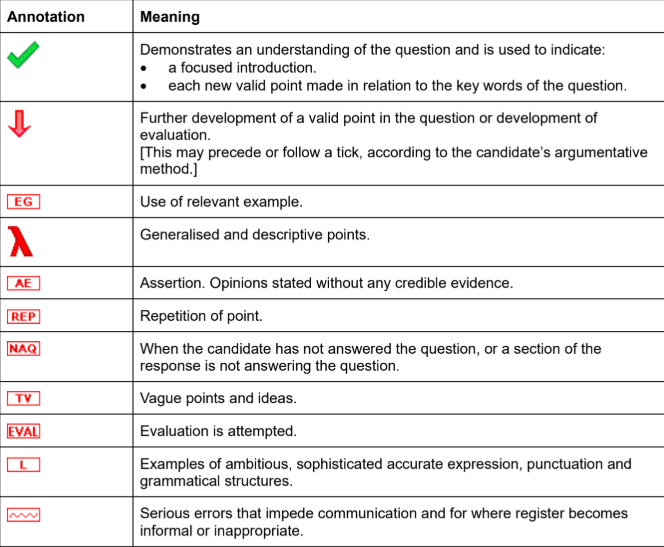How your Paper 1 Essay is Marked (Cambridge (CIE) AS English General Paper): Revision Note
Exam code: 8021
Preparing for the CIE AS English General Paper Paper 1 essay means understanding not just what to write, but how your essay is marked. This guide explains the marking process, Assessment Objectives (AO1, AO2, AO3), and Generic Level Descriptions (GLDs), helping you aim for a Level 5 essay (25–30 marks).
In this guide you will find:
Understanding how Paper 1 is marked
Assessment Objectives and weighting
The five marking levels from 1 to 5
What a level 5 essay looks like (25-30 marks)
Common mistakes that lower marks
How Paper 1 marking works in practice
Understanding how Paper 1 is marked
Paper 1 uses criterion-referenced marking, which means your essay is judged against clear performance criteria, not compared with other candidates.
Examiners will:
Place your essay into a Level (1–5) using the Generic Level Descriptions
Fine-tune your mark within that level, depending on how strongly you meet the descriptors
The higher your level, the stronger your:
Use of examples and information (AO1)
Analytical and evaluative thinking (AO2)
Communication and structure (AO3)
The top level of the mark scheme looks like this:

Assessment Objectives (AOs) and weighting
AO | What it tests | Weighting |
|---|---|---|
AO1 | Selection and application of information | 20% |
AO2 | Analysis and evaluation | 35% |
AO3 | Communication using written English | 45% |
As you can see, AO3 (communication) has the highest weighting, so clarity, organisation and control of language are key.
Examiner Tips and Tricks
If you are taking your exam from 2028 onwards, both AO1 and AO2 will be weighted equally at 25%, with AO3 still having the highest weighting at 50%. The total marks available for the essay will also increase from 30 to 40.
The five marking levels from 1 to 5
Your essay is placed in one of five levels, each representing a performance band.
Level-to-mark range table
Level | Mark range | Descriptor summary |
|---|---|---|
Level 5 | 25-30 |
|
Level 4 | 19-24 |
|
Level 3 | 13-18 |
|
Level 2 | 7-12 |
|
Level 1 | 1-6 |
|
What a level 5 essay looks like (25–30 marks)
AO1: selection and application of information
Selects fully relevant, accurate examples
Applies evidence precisely to support each main point
Avoids irrelevant or superficial material
Demonstrates sound judgement supported by well-chosen examples
AO2: analysis and evaluation
Clearly defines the scope of the question in the introduction
Develops balanced, logical arguments that explore different perspectives
Evaluates evidence and ideas before reaching a supported conclusion
Ends with a reasoned, evaluative judgement that links back to the question
AO3: communication in written English
Uses accurate, controlled, and varied language
Maintains a formal, academic tone appropriate for an international audience
Links ideas smoothly and logically across paragraphs
Demonstrates command of structure and coherence; errors are rare and minor
Common mistakes that lower marks
Descriptive writing: listing facts without evaluation or analysis
Ignoring key terms: missing qualifiers like “to what extent” or “evaluate”
Too few examples: relying on general assertions instead of evidence
Informal tone: using colloquial or conversational language
Language errors: repeated grammatical mistakes affecting clarity
Repetition: restating ideas without adding new insight
Remember, the examiners are assessing your thinking as well as your writing. Show that you can reason critically and communicate effectively.
How Paper 1 marking works in practice
Examiners assess your essay as a whole, not by awarding marks separately for each AO. They consider how well you meet all three Assessment Objectives together. The level sets your mark range, and then finer adjustments are made within that range. Remember, to reach Level 5, all three AOs (knowledge, evaluation and communication) must be consistently strong. Weakness in one can limit your final level.
When the examiners mark your essay (or script), they will annotate it using the following symbols:

Examiners will award the highest marks to candidates who demonstrate a well-organised and focused management of the discussion the question provokes, and use clear and accurate communication. They want to see the careful selection and application of information (evidence) and effective analysis and evaluation, rather than a list of points with vague or brief evidence. Any explanation or judgement you make is made stronger by supporting it with the use of relevant examples.
Frequently asked questions
Q. How long should my essay be?
A. Aim for 600–700 words — quality of argument matters more than word count.
Q. Do I lose marks for short essays or for going over the suggested word limit?
A. Not directly, but shorter responses usually lack analysis and supporting evidence. Answers that are too long wander off topic and lack focus.
Q. Are spelling and grammar marked separately?
A. No, they are part of AO3 (communication). Frequent errors will lower your mark.
Q. Can I use personal examples?
A. Yes, if relevant and well explained. Link them clearly to your argument.
Q. How do I show evaluation?
A. By weighing up different perspectives, questioning assumptions and drawing reasoned conclusions.
Final thought
Success in CIE AS English General Paper, Paper 1, depends on combining strong ideas with clear communication. A Level 5 essay demonstrates balance, insight and control, showing the examiner that you understand the question, think critically and express yourself with precision.

Unlock more, it's free!
Did this page help you?